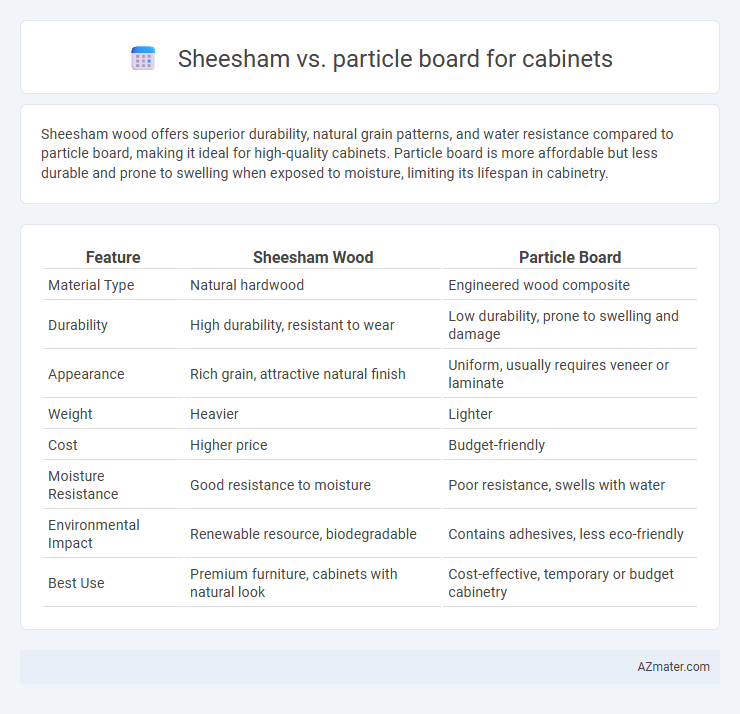Sheesham wood offers superior durability, natural grain patterns, and water resistance compared to particle board, making it ideal for high-quality cabinets. Particle board is more affordable but less durable and prone to swelling when exposed to moisture, limiting its lifespan in cabinetry.
Table of Comparison
| Feature | Sheesham Wood | Particle Board |
|---|---|---|
| Material Type | Natural hardwood | Engineered wood composite |
| Durability | High durability, resistant to wear | Low durability, prone to swelling and damage |
| Appearance | Rich grain, attractive natural finish | Uniform, usually requires veneer or laminate |
| Weight | Heavier | Lighter |
| Cost | Higher price | Budget-friendly |
| Moisture Resistance | Good resistance to moisture | Poor resistance, swells with water |
| Environmental Impact | Renewable resource, biodegradable | Contains adhesives, less eco-friendly |
| Best Use | Premium furniture, cabinets with natural look | Cost-effective, temporary or budget cabinetry |
Introduction: Sheesham vs Particle Board Cabinets
Sheesham wood, known for its durability and rich grain patterns, offers a high-quality and long-lasting option for cabinets, prized in premium furniture making. Particle board cabinets provide a budget-friendly alternative, made from compressed wood particles bonded with resin, suitable for economical and lightweight cabinetry. Comparing Sheesham to particle board highlights key differences in strength, aesthetics, and moisture resistance crucial for cabinet longevity.
Material Composition and Origins
Sheesham wood, derived from the Dalbergia tree native to India and Pakistan, is renowned for its dense hardwood composition with natural oils that enhance durability and resistance to pests. Particle board, manufactured from compressed wood chips, sawdust, and resin binders, offers an economical alternative but lacks the natural resilience and grain patterns of solid wood. The organic origin and solid structure of Sheesham provide superior strength and aesthetics compared to the engineered, uniform texture of particle board commonly used in budget cabinetry.
Durability and Longevity Comparison
Sheesham wood offers superior durability and longevity compared to particle board, making it ideal for high-quality cabinets that withstand wear and tear over time. Its natural density and resistance to moisture, insects, and warping ensure a longer lifespan, while particle board, composed of compressed wood chips and resin, tends to degrade faster under stress and exposure to humidity. Cabinets crafted from Sheesham maintain structural integrity and aesthetic appeal for decades, whereas particle board requires replacement or repairs more frequently due to susceptibility to sagging and swelling.
Appearance and Aesthetics
Sheesham wood boasts a rich, natural grain with warm amber and brown hues, creating a luxurious and timeless appearance ideal for high-end cabinetry. Particle board, typically covered with laminate or veneer, offers a uniform but less authentic look, often lacking the depth and texture found in solid wood. The natural variations and intricate patterns in Sheesham enhance the visual appeal and uniqueness of cabinets, making them stand out compared to the flat, synthetic surface of particle board.
Cost Analysis: Budget Considerations
Sheesham wood cabinets are typically more expensive due to their durability, natural grain patterns, and resistance to wear, making them a premium choice for long-lasting furniture. Particle board cabinets are budget-friendly options, offering a lower upfront cost but often requiring replacement or repairs sooner due to susceptibility to moisture and damage. When considering cost analysis for cabinets, Sheesham provides better long-term value despite higher initial expenses, while particle board suits projects with limited budgets and short-term usage.
Weight and Handling Differences
Sheesham wood is denser and heavier than particle board, making cabinets sturdier but more difficult to handle during installation. Particle board, being lightweight, allows easier maneuverability and quicker setup but often compromises durability and structural strength. The choice between the two depends on balancing ease of handling with the desired robustness and longevity of the cabinet.
Maintenance and Care Requirements
Sheesham wood cabinets require regular maintenance, including periodic oiling and polishing, to preserve their natural grain and prevent drying or cracking, ensuring long-term durability and aesthetic appeal. Particle board cabinets demand minimal upkeep due to their laminated surface, which resists stains and moisture, but they are more susceptible to swelling or damage if exposed to excessive water or high humidity. Choosing Sheesham offers rich texture and longevity with moderate care, while particle board provides a budget-friendly, low-maintenance alternative suitable for controlled environments.
Environmental Impact and Sustainability
Sheesham wood, known for its natural durability and biodegradability, offers a more sustainable option for cabinets compared to particle board, which often contains synthetic resins and formaldehyde that can release harmful volatile organic compounds (VOCs). The harvesting of Sheesham is sustainable when sourced from responsibly managed plantations, supporting carbon sequestration and reduced deforestation impacts. In contrast, particle board is typically made from wood waste and adhesives but has a shorter lifespan and limited recyclability, increasing landfill waste and environmental pollution.
Suitability for Different Applications
Sheesham wood offers superior durability and natural resistance to moisture, making it ideal for high-end cabinetry and furniture requiring long-lasting strength and aesthetic appeal. Particle board, while more cost-effective and lightweight, is better suited for temporary or budget-friendly cabinets in low-moisture environments due to its susceptibility to warping and damage from humidity. Choosing between Sheesham and particle board depends on the cabinet's intended use, with Sheesham favored for premium, durable applications and particle board for economical, short-term installations.
Final Verdict: Which is Better for Cabinets?
Sheesham wood offers superior durability, natural water resistance, and a rich grain pattern, making it ideal for high-quality, long-lasting cabinets. Particle board is more cost-effective and lightweight but lacks the strength and moisture resistance needed for cabinetry exposed to humidity or heavy use. For cabinets requiring durability and aesthetic appeal, Sheesham is the better choice, while particle board suits budget-friendly, low-moisture environments.

Infographic: Sheesham vs Particle board for Cabinet
 azmater.com
azmater.com